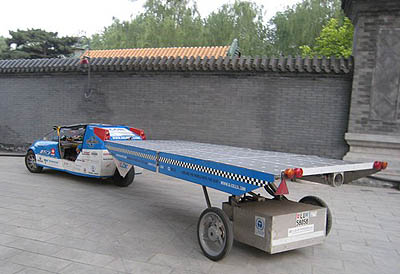|

The Solartaxi, the first solar car to be driven around the world, is on the verge of completing its 39-day tour of China to raise environmental awareness. Beijing will be the last stop for the Solartaxi Innovation Tour in China from May 20-24. Energy initiatives for the 2008 Olympic Games will be explored during this trip.
Louis Palmer, the maverick inventor, and his invention have visited government institutions, environmental protection agencies, and corporations all over China, working to reduce global warming. The Solartaxi is a showcase for Swiss innovation and the forward-looking research and solutions practiced in Switzerland, with respect to renewable energy and environmental protection.
As the host of 2008 Olympic Games, Beijing has worked to incorporate clean energy practices -- such as solar power systems -- in the construction of its sporting venues. The Beijing Olympic Village, which will host up to 16,000 people during the Games, will heat most of its water with solar energy. As the main stadium of the Games, the Bird's Nest will be the first to utilize Olympic stadium solar power systems and will have a total power capacity of 130 kilowatts. In addition, these systems will provide 90 percent of the energy for lawn and road lamps at Olympic venues. The lighting systems for Olympic venues also utilize new generation environment-friendly semiconductors that use 70 percent less landscape lighting in landmark locations, such as the National Swimming Center and the Olympic central area. Furthermore, the Solar Tracking System, also solar powered, will be used at Olympic venues for the first time.
Louis Palmer and his car have visited the Bird's Nest (which was designed by Swiss architects Herzog and de Meuron), Water Cube, Tiananmen Square, The Great Wall, and the Ming Tombs. Wherever the Solartaxi traveled in the city, people expressed great curiosity, taking photos and giving Louis Palmer a thumbs-up for his unique way of publicizing the importance of environmental protection. Tu Mingde, Vice President of the China Olympic Committee and Assistant President of the Beijing Organizing Committee for the Games of the XXIX Olympiad (BOCOG), praised the Solartaxi for spreading eco-friendly ideals.
Louis Palmer commented, "Global warming is an increasingly important issue, and we all must contribute to finding a solution. I cannot change the world alone, but I can show how everyone can make a difference in the efforts against global warming. I am honored to visit China before the Olympics and to learn about the clean energy practices incorporated in the construction of Olympic venues."
Juerg Burri, the Minister of the Embassy of Switzerland, stated in today's press conference, "To address global warming, the Swiss government utilizes the program SwissEnergy, aimed at promoting clean energy, preventing global warming, developing technology, and sharing experiences in generating renewable energy, through cooperation with the governments, states, and the newly founded Energy Community. As global warming affects all countries, Switzerland is conducting heavy research on solar energy practices. We seek to promote communication through this environmental awareness tour in China, building cooperation opportunities for the future."
Louis Palmer also visited the China University of Political Science and Law, and the No. 2 Middle School, discussing his travel experiences and the need for everyone to participate in environmental protection. An audience of over a thousand teachers and students listened to him with rapt attention.
The Solartaxi will depart for South Korea -- the next stop in its global route -- this weekend. The car was designed and developed by four Swiss technical universities, with support from leading Swiss technology companies who provided most of the materials for the car. The vehicle generates 50 percent of its energy from a trailer equipped with high-efficiency solar cells from main sponsor, Q-Cells. The other 50 percent of the car's energy needs are fed into the electrical grid from a solar station in Switzerland. The vehicle can run non-stop for 400 km in sunlight; without sunshine it can travel 300 km. The Solartaxi is a 100 percnet climate friendly vehicle that emits no exhaust and produces no carbon dioxide.
The Solartaxi launched its world tour on July 3, 2007, in Lucerne, Switzerland, and will eventually cover 50 countries over five continents in 18 months, making China the 25th stop of the journey. The car has two seats, with a steering wheel that can be shifted to either side. It gets its name from the extra seat, which carried many passengers during its world tour. The China tour began in Yunnan Province, and went through the Guangxi, Guangdong, Jiangxi, Zhejiang, and Jiangsu provinces. In 39 days the car traveled 6,419 km. |
